I’m making an 1813 dress for the challenge mainly because I found this amazing wool twill at Global a few years ago and knew the pattern was taken directly from early 19th century paisley shawls. I immediately thought of the Regency dresses made from paisley shawls, and snapped up the fabric, and then waited for an excuse to make it up.

Paisley borders on the twill weave
When this challenge came up I did a quick inventory of my stash, and realised how perfect this fabric and project would be for the challenge. Well, almost perfect. The fabric isn’t exactly like a paisley shawl, which means that making it up is always going to entail a compromise between the fabric and what would have been done historically. It is, however, as close as I am ever likely to be able to find to an early 19th century paisley shawl, so for that reason I’m happy with it.
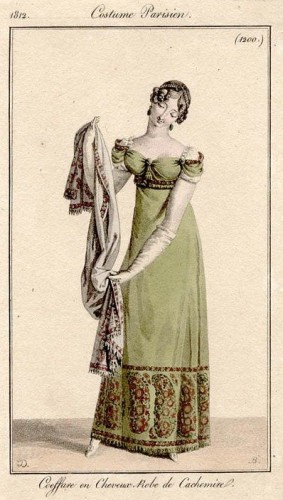
Fashion plate featuring a dress made of Kashmiri shawls, 1812
What are the compromises? For starters, the fabric comes in 1.5m panels, with a wide border along one selvedge, and a narrow border separating it from the next panel. I bought two panels and will have to carefully cut and arrange to get a 1813 ballgown out of the length.
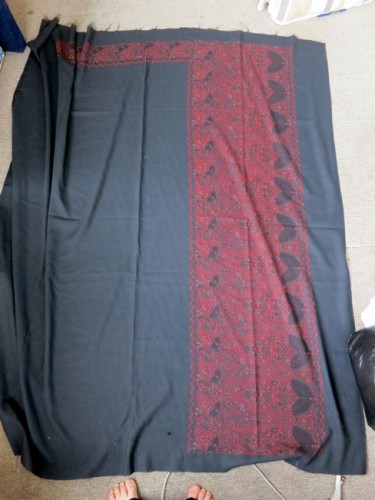
One full panel of fabric (and my toes)
The twill weave isn’t precisely historical either – it will give a lovely drape to the skirt, but will need to be wrangled into submission in the bodice.
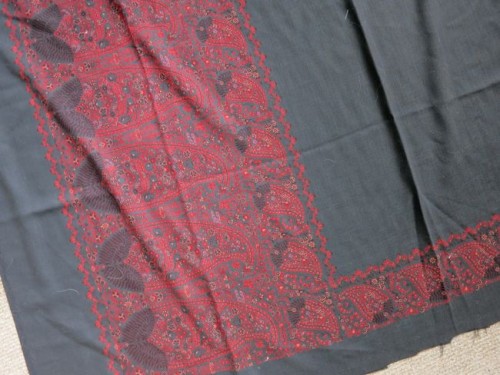
The two borders meeting each other
The pattern isn’t quite right: it should have a single border of large paisley, rather than a large border topped by a narrow border. I thought about cutting off the wide border and piecing it to the plain end to create the correct border, but decided it wouldn’t look right. There are also example of Western designers playing with the paisley motif, creating borders (like the double border below) and combinations not found in traditional Kashmiri design, so the design is plausible, if not precisely accurate.
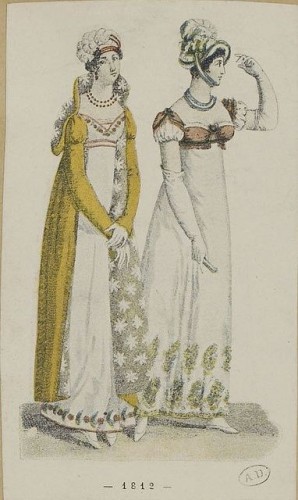
Fashion plate featuring a dress made from Kashmiri shawls (right), 1812
Finally, and the big one aesthetically: the colours are off. The red tones are perfect, but I haven’t been able to find an example of a paisley shawl, Kashmiri or Western, with a grey background. The closest I can get is the dark blue dress from a shawl in the 1811 Lefevre portrait of Salome Louise Coulmann. Still, the fabric didn’t come in any other colourways, and there is nothing I can do about the colours, so I’ll just live with them.

Salome Louise Coulmann, comtesse Walther by Robert Lefevre, 1811, Versailles
So things aren’t perfect. My aim with this dress will be to be as historically accurate as possible, and as close to the inspiration fashion plate as possible, within the limitation of the fabric.
To start, I carefully cut off the narrow borders which transect the fabric, and set these pieces aside to be used in the bodice.
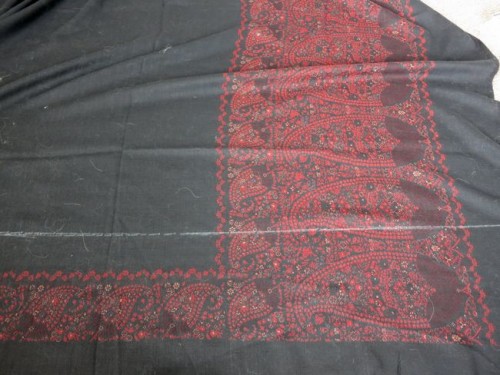
Chalk lines to mark where I will cut
Then I hand sewed the two long panels together to form the skirt – the skirt will be completely flat fronted, with the fullness pleated into the back.
While skirts were beginning to use gored side panels in the 1810s to create the desired cone shape, it’s clear from the fashion plates and extent examples that most dresses made from or inspired by Kashmiri shawls still had skirts made from rectangular fabric lengths, to keep the paisley border quite even.
Next: the bodice.

Looking forward to seeing the final product!
Laurie
I must show Mum – I bought her some of this and she has made wide leg trousers with it! Lovely stuff. It will be sooo preeetty!
I always wondered what the other lengths ended up as! Thank you!
Fascinating! I’m really interested to see the progress shots. And I know the grey isn’t historical, but red and grey is one of my all time favourite colour schemes, so I absolutely love it.
I have a question: how do you get a completely flat front to fit nicely? How do stop it pulling across the front of the body?
Thank you. I’m confused about your question about the flat front though. It will curve around the body (of course) and the fullness of pleating at the back will naturally open out as it fall, providing width for the hips. Does that make sense?
Sorry, that wasn’t the clearest question I’ve ever asked! But I think your reply answers it. Essentially I wanted to know how the flat front design manages to get enough width to acommodate the hips without using gores.
Can’t wait to see the finished version!
I don’t know about the twill being anachronistic, though. As far as I’m aware, historically the proper Kashmir (and the good imitations) shawls were twill-woven.
Thank you! Yes, historically Kashmiri shawls were twill-weave, but not the same twill weave as my fabric, and it does make them drape and handle differently.
Interesting fabric! It’s close, at least, to what was used in some of the historical dresses. I look forward to seeing what you can make of it.
Fabulous fabric. You must have iron self control to have limited yourself to two panels. I eagerly await the dress.
Thank you! I don’t have iron self control so much as the weight of a huge stash already leaning against me pushing me away from new purchases
can’t wait to see…will you use the salvage as detail?
Thank you! Do you mean the narrow border I cut off? Yes, that will be the bodice.
I’m sure you will knock it out of the park! Wouldn’t it be nice if you could just call up a fabric mill and say, “I liked that fabric but could you do it in white, just for me…and lower the price.”
Lol!!!
Oh, I’m also so looking forward to seeing what you make of it! I love all those paisley dresses… That blue one, yum! It even retained the fringing of the shawl, just like the first one, interesting… I wonder whether that could be where the Victorian love of all things fringed came from?
Oh, and please, definitely record how you struggle with your lengths of fabric! Those kinds of posts are always very interesting and helpful.
Hi!
I’m new to this blog & find it absolutely fascinating!
Brilliantly written also.
And guess what?
My husband is Kashmiri (from Srinagar) and we sell Kashmiri handicrafts, antique & modern.
Yes, I have an example darned of near every shawl & fabric ever made in Kashmir & Jammu going back to the 16th century. (I also collect clothing of all Indian ethnicities.)
That gray is definitely possible in many of the wools used in Kashmiri shawls- not all ‘cashmere’ is ‘cashmere’ from the Cashmere goat (Capra circus laniger).
The three most popular wools used in Kashmiri shawls are cashmere, pashmina & shahtush.
Shahtush or shahtoosh (Persian for ‘king of fine wools’) is the most rare & highly valued. The wool comes from the underside of the Tibetan antelope also called a ‘Chiru’ that live around 15,000ft. The wool is especially fine & a typical shawl made from shahtoosh wool can easily slide through a wedding ring – hence shahtoosh shawls are often referred to as ‘ring shawls’. Wearing shahtoosh wool is also supposed to be beneficial for heart problems.
Shahtush wool is usually left undyed and is available in a sort of ‘dove grey’ (much like your fabric) or an ‘oatmeal’ color. The colors chosen for embroidery on a shahtoosh shawl are the pink (traditionally from cockscomb flowers) and orange/yellow (traditionally from the famous Kashmiri saffron).
Pashmina is from another tiny goat called the ‘changthangi’ that lives at around 14,000 ft.. It’s wool fiber is slightly larger than the shahtush & is not as rare nor quite as valuable. Undyed pashmina wool is available in an off-white, grey, and black.
Cashmere (as I mentioned above) is from yet another goat that lives at around 14,000 ft and is domesticated. It has the largest diameter of wool fibers & is not as expensive or ‘rare’ as shahtush or pashmina.
Undyed it comes in a light gray or black.
Quality can also be determined by whether the wool comes from the neck or underside of the animal.
Gracious, I have gone on quite a rant.
Anyway, you are correct that pattern is not quite right to be Kashmiri at the time.
I am curious to know if the pattern is embroidered on or woven in to the fabric. A Jammuwar shawl would have the design typically woven in, a Kashmiri shawl would be typically hand embroidered.
Toodle pip!
PS
If you look at the shawl the young lady is holding it appears to have an off white or possibly light gray background?
Hmmmmmm…….